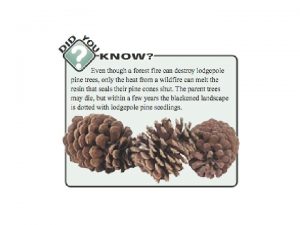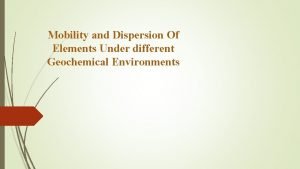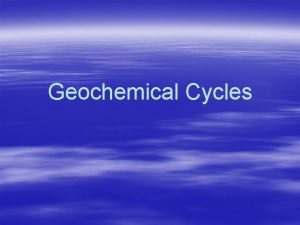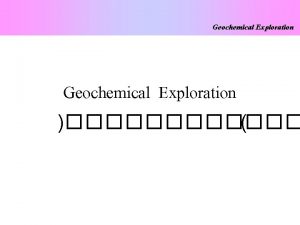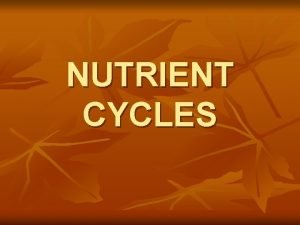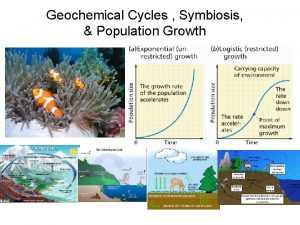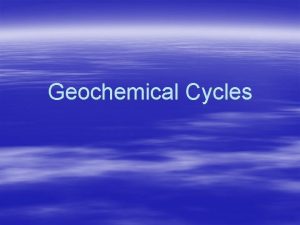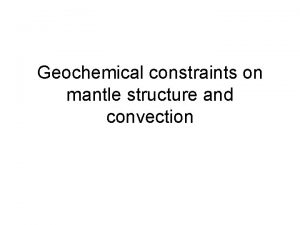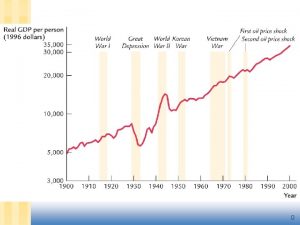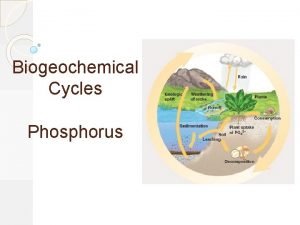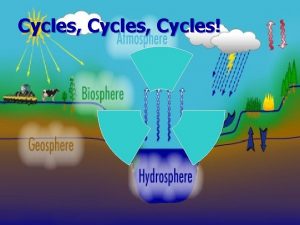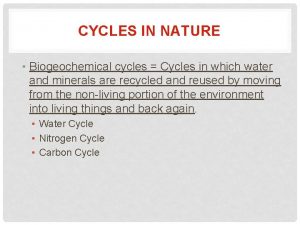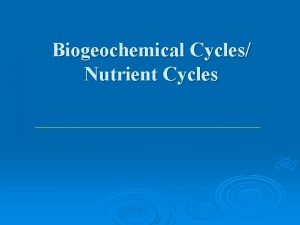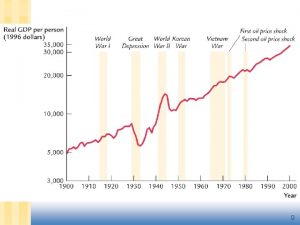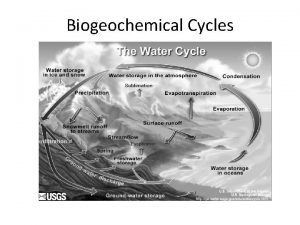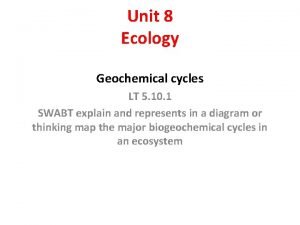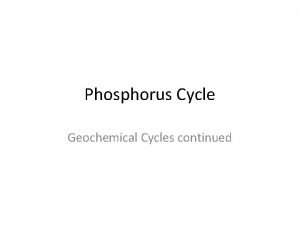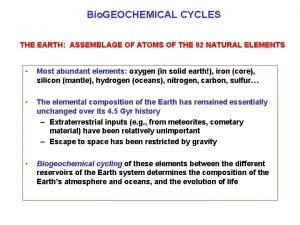Geochemical Cycles Geochemical cycles represent the movement of






















- Slides: 22


Geochemical Cycles • Geochemical cycles represent the movement of a particular form of matter through the living and nonliving parts of an ecosystem. – The 3 main cycles that we will study are: • Water (Hydrologic) • Carbon • Nitrogen Since matter can neither be created nor destroyed, and Earth is a closed system, these essential nutrients must be continuously cycled.

The Water Cycle • The chemical formula of water is H 2 O, and this is necessary for the life processes of all living things. • Water is found in… – Earth’s surface (including oceans, lakes, rivers, etc. ) • 97% is in the ocean! • Of the 3% that is freshwater, 2% is frozen in glaciers – Under Earth’s surfaces (groundwater, aquifers) – In the atmosphere – In living organisms

The Water Cycle • This cycle is driven by the sun, which causes evaporation from reservoirs and organisms.

The Water Cycle • The main stages include: – Precipitation: water falls to Earth as a liquid (usually rain, sleet or snow) – Runoff: liquid water that isn’t infiltrated runs along the surface and collects in puddles, lakes, oceans, or other bodies of water. – Infiltration: some water seeps from the surface of the Earth to underground aquifers

The Water Cycle • The main stages include: – Evaporation: sun heats liquid water to vapor and it rises to the atmosphere – Transpiration: water rises back into the atmosphere as water vapor from plants – Condensation: water condenses to form clouds before precipitating again

Living Organisms and the Water Cycle • All organisms take in water for nutrient transport, chemical reactions, diffusion, etc. – Which means, they also have to eliminate water too (urine/feces) • All organisms release water when breaking down food for energy (cellular respiration) C 6 H 12 O 6 + 6 O 2 6 CO 2 + 6 H 2 O + ATP • Plants take in water to make sugar (photosynthesis) 6 CO 2 + 6 H 2 O C 6 H 12 O 6 + 6 O 2

Think about it… • What about human participation in the water cycle? How do we contribute to the cycle as living organisms? How do we negatively impact the cycle? • Negative Human Impact: – Deforestation: transpiration – Paving/Building/Development: Infiltration – Pollution Runoff and

The Carbon Cycle • Carbon is another molecule necessary for life to exist. • Carbon is found in… – Macromolecules, which are large molecules necessary for life. • • Proteins (muscle, skin, etc…) Carbohydrates (food, sugars) Lipids (fats) Nucleic acids (DNA and RNA)

The Carbon Cycle • Carbon is found in… – Our atmosphere (as CO 2) – Minerals and rocks – Fossil fuels (coal, oil, natural gas) – Organic (living) materials in soil or aquatic sediments • Note: Carbon changes forms as it cycles, unlike water, which is always H 2 O – Ex. Carbon is CO 2 in the atmosphere, but C 6 H 12 O 6 as glucose in plants

The Carbon Cycle • The main stages include: – Photosynthesis: plants capture CO 2 from the atmosphere and use it to make sugar – Cellular Respiration: CO 2 released into atmosphere as waste from metabolism – Consumption: one organism eats another for carbon

The Carbon Cycle • The main stages include: – Combustion: CO 2 released into atmosphere from burning – Decomposition: decomposers break down carbon from dead organisms, allowing it to be recycled in the soil – Fossilization: converts carbon from once-living organisms into a fuel source through intense heat and compression, including natural gas, oil, and coal (fossil fuels)

Living Organisms and the Carbon Cycle • Decomposers (like bacteria and fungi) break down dead materials and return the nutrients (like Carbon) to the soil • Photosynthetic organisms (like plants and algae) remove CO 2 from the atmosphere and convert it into simple sugars. • Animals, plants and fungi do cellular respiration in order to break down carbon-rich foods for energy

Think about it… • What about human participation in the carbon cycle? How do we contribute to the cycle as living organisms? How do we negatively impact the cycle? • Negative Human Impact: – Combustion: when wood or fossil fuels, which contain carbon, are burned causing major of CO 2 in the atmosphere

The Nitrogen Cycle • Nitrogen is the last molecule necessary for life to exist that we will focus on. • Nitrogen is found in… – Two Macromolecules: Proteins and Nucleic acids – In the atmosphere in the form of a gas - N 2 (elemental nitrogen) • Note: Plants and animals can NOT use nitrogen in this form!! – Fossil fuels – Waste – Soil

The Nitrogen Cycle • The main stages include: – Nitrogen fixation: Bacteria (or lightning!) in the soil or water convert nitrogen (from the air or water) into forms that plants can use

The Nitrogen Cycle • The main stages include: – Decomposition: decomposers like bacteria break dead matter down, returning nitrogen to the soil.

The Nitrogen Cycle • The main stages include: – Ammonification: Bacteria convert nitrogen from waste (urine and feces) into ammonia.

The Nitrogen Cycle • The main stages include: – Nitrification: Bacteria convert nitrogen in ammonia into nitrates and nitrites to be absorbed by plants in their roots. • This is how nitrogen enters the food chain, and eventually reaches us.

The Nitrogen Cycle • The main stages include: – Denitrification: bacteria convert nitrogen in ammonia to N 2 so it can go back into the atmosphere

Living Organisms and the Nitrogen Cycle • The nitrogen cycle is different from other geochemical cycles, in that no step is completed without the help of living organisms. – Bacteria is most important living organism in converting nitrogen to different forms. – Fungi and other decomposers breakdown nitrogen-rich waste and put it in the soil

Think about it… • What about human participation in the nitrogen cycle? How do we contribute to the cycle as living organisms? How do we negatively impact the cycle? • Negative Human Impact: – Fertilizers: The use of fertilizers adds WAY too much nitrogen to the soil, creating an imbalance • This excess nitrogen can get into groundwater which can be dangerous to drink – Combustion: not as major of an impact on the nitrogen cycle as the carbon cycle, but burning fossil fuels does release excess nitrogen into the atmosphere
 Practice geochemical cycles answer key
Practice geochemical cycles answer key Primary and secondary geochemical dispersion
Primary and secondary geochemical dispersion Locomotor movement examples
Locomotor movement examples Control tower light signals
Control tower light signals Vẽ hình chiếu vuông góc của vật thể sau
Vẽ hình chiếu vuông góc của vật thể sau Chúa yêu trần thế
Chúa yêu trần thế điện thế nghỉ
điện thế nghỉ Một số thể thơ truyền thống
Một số thể thơ truyền thống Trời xanh đây là của chúng ta thể thơ
Trời xanh đây là của chúng ta thể thơ Sơ đồ cơ thể người
Sơ đồ cơ thể người Cong thức tính động năng
Cong thức tính động năng Các số nguyên tố
Các số nguyên tố Tỉ lệ cơ thể trẻ em
Tỉ lệ cơ thể trẻ em đặc điểm cơ thể của người tối cổ
đặc điểm cơ thể của người tối cổ Các châu lục và đại dương trên thế giới
Các châu lục và đại dương trên thế giới ưu thế lai là gì
ưu thế lai là gì Môn thể thao bắt đầu bằng từ chạy
Môn thể thao bắt đầu bằng từ chạy Tư thế ngồi viết
Tư thế ngồi viết Cái miệng bé xinh thế chỉ nói điều hay thôi
Cái miệng bé xinh thế chỉ nói điều hay thôi Hát kết hợp bộ gõ cơ thể
Hát kết hợp bộ gõ cơ thể Mật thư tọa độ 5x5
Mật thư tọa độ 5x5 Từ ngữ thể hiện lòng nhân hậu
Từ ngữ thể hiện lòng nhân hậu Tư thế ngồi viết
Tư thế ngồi viết
